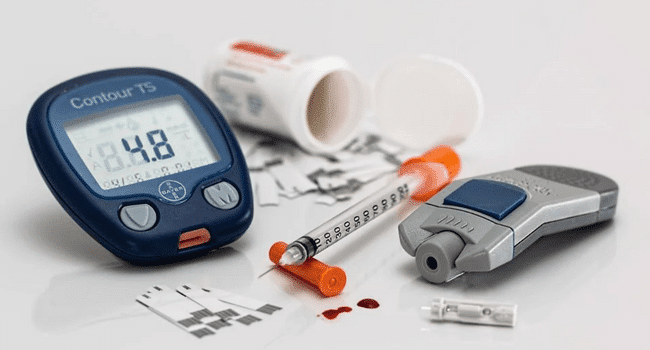Table of Contents
Introduction
Diabetes Inspidus is a medical condition characterised by the body’s inability to retain urine properly. It results in frequent urination and extreme thirst. While a healthy individual produces between 946.4 mL to 2.84 L of urine daily, diabetes insipidus patients produce up to 18.9 L of urine every day.
There are various methods of diabetes treatment which can help in the management of diabetes insipidous. Read this article to learn about this condition’s causes, symptoms, risk factors, and treatment.
Types of Diabetes Insipidus
There are four types of diabetes insipidus. They are as follows:
- Central diabetes insipidus: It is a common type of diabetes insipidus developed due to a damaged hypothalamus or pituitary gland. It results in low or no antidiuretic hormone (ADH or vasopressin) production.
- Nephrogenic diabetes insipidus: It is characterised by kidney damage. This results in our kidney’s inability to respond to the ADH hormone.
- Dipsogenic diabetes insipidus: It is a type of diabetes insipidus where the thirst mechanism of the hypothalamus is damaged. This results in feeling extremely thirsty and frequently urinating.
- Gestational diabetes insipidus: A rare type of diabetes insipidus that develops during pregnancy. It may be due to excess hormone production that breaks down too much of ADH. It may also develop due to increased levels of prostaglandin, a hormone that makes our kidneys less responsive to ADH.
Symptoms of Diabetes Insipidus
The main symptoms of diabetes insipidus are:
- Polydipsia, uncontrollable and excessive thirst
- Frequent urination
- A large amount of urine
- Dehydration
- Dizziness
- Fatigue
- Dry eyes, lips, and mouth
- Nausea
- Difficulty focusing on simple tasks
If we experience severe dehydration and the above symptoms, we should seek medical help immediately.
Causes of Diabetes Insipidus
The following factors cause central diabetes insipidus:
- Damaged pituitary gland or hypothalamus from surgery
- Tumours
- Genetic mutation on chromosome 20
- Damaged pituitary gland or hypothalamus from injury
- Inflammation from tuberculosis or sarcoidosis
The following factors cause nephrogenic diabetes insipidus:
- Medications like tetracycline or lithium
- Hypercalcemia – High levels of calcium in the blood
- Hypokalemia – Low levels of potassium in the blood
- Blocked urinary tract
- Genetic mutation
- Chronic kidney disease
The following factors cause dipsogenic diabetes insipidus:
- Damaged hypothalamus from surgery, infection, injury, or inflammation
- Mental health issues like schizophrenia
Gestational diabetes insipidus develops when our placenta overproduces an enzyme that destroys ADH.
Risk Factors Associated with Diabetes Insipidus
The following factors may increase my risk of developing diabetes insipidus:
- Family history of diabetes insipidus
- Brain surgery
- Severe head injury
- Preeclampsia
- HELLP syndrome
- Medications for kidney conditions
Treatment for Diabetes Insipidus
For diabetes insipidus, the doctor will decide on a diabetes treatment based on the type and severity of the diabetes insipidus.
- Central and Gestational Diabetes Insipidus: Desmopressin is the line of diabetes treatment for central and gestational diabetes. It is an artificial hormone that acts like vasopressin. It is available as a nasal spray, injection, or pill. We must regulate and manage the daily water intake. However, if a tumour or other pituitary gland issue is the cause, the doctor will treat that first. After treatment, they will determine if diabetes treatment.
- Nephrogenic Diabetes Insipidus: This type of diabetes insipidous requires a hybrid approach. The doctor may prescribe a combination of desmopressin, non-steroidal anti-inflammatory medications, and diuretics to reduce urine production in the kidneys. If medications cause nephrogenic diabetes, they may replace or stop these medications. However, we should not stop taking medicines or alter the dosage unless the doctor says so.
- Dipsogenic Diabetes Insipidus: There is currently no diabetes treatment for dipsogenic diabetes. However, the doctor may direct us towards a mental health professional if a mental health issue is a cause of diabetes insipidous.
Side Effects of Desmopressin
The following side effects are seen after taking desmopressin:
- Nausea
- Headache
- Abdominal pain
- Bloating
- Dizziness
- Confusion
- Vomiting
- Low levels of sodium in your blood
- Runny or blocked nose
When to See a Doctor?
We should visit the doctor regularly to monitor and manage diabetes insipidous. Additionally, if we experience severe dehydration and symptoms like fatigue and nausea, we should seek medical help immediately.
Conclusion
Diabetes insipidus is a rare medical condition that causes frequent urination and excessive thirst. We can develop any type of diabetes insipidus due to multiple factors. Additionally, we may develop dehydration which may cause dizziness, fatigue, and nausea.
The diabetes treatment depends on the type and severity of the diabetes insipidus. We should consult a doctor immediately if we experience severe dehydration or side effects after taking desmopressin.
Read more on KulFiy
